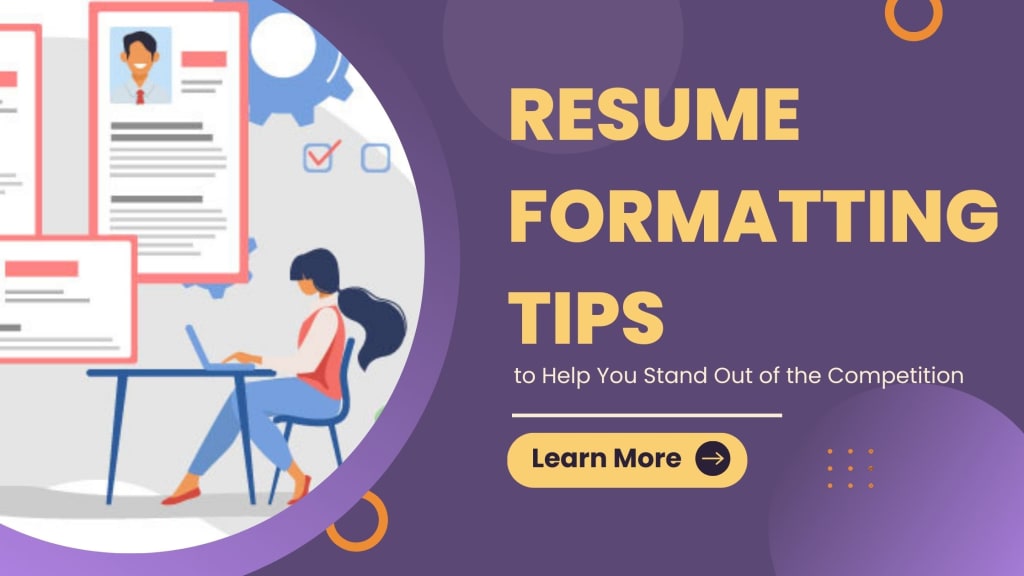Resume Formatting Tips to Help You Stand Out of the Competition
A well-crafted resume can be your entry ticket to your dream job as it provides a snapshot of your professional journey.

A well-crafted resume can be your entry ticket to your dream job as it provides a snapshot of your professional journey. However, writing a resume is more technical than it appears. It creates the first impression, which might be your last impression on the recruiters and hiring managers if it is not content enriched or visually appealing and doesn’t offer them what they are looking for.
At the same time, formatting a resume is not rocket science or abstract art—you need to follow some dos and don’ts to create a resume that lands you the interview hot seat of your dream job. Important of all you need to make sure that your document is ATS-friendly; meaning, that your resume is written in a language that is understood by the algorithms.
Take a look at these quick resume formatting tips and tricks to create a professional and visually appealing resume:
Choose an Easy-to-read Font: Use a clean and professional font that is easy to read and widely accepted, such as Calibri, Arial, or Times New Roman. It is better to use sans-serif fonts as the text can open correctly on all devices. Stick to a font size between 10 and 12 points for the body text and slightly larger (between 14-15 points) for headings. Use the same font throughout the document so that it looks neat and clean.
Ensure Consistency in Formatting: Maintain consistency in formatting throughout your resume. Use the same font type and size as well as formatting styles (bold, italic, underline) consistently for headings, subheadings, and content. For instance, use bold, underline, and capitals for section headings like achievements, and professional synopsis, bold font for company names, and italics for titles. These simple changes give your resume a more cohesive and organized look.
Leave Sufficient White Space: Your resume becomes visually appealing and easy to navigate when you ensure that there’s enough white space between sections and within the content. Do not overcrowd your resume with too much text or excessive formatting. Besides, leaving sufficient white space helps in decluttering words and phrases, making your resume more reader-friendly.
Use Short Bulleted Points: Rather than writing lengthy paragraphs, use bullet points to highlight your achievements, skills, and experiences. Bullets make the content more scannable and easier to consume, helping the reader grasp your qualifications quickly. It is good if you start each bullet with strong action verbs like deployed, initiated, created, developed, and so on.
Divide Resume into Clear Sections: Prioritize sections with headings such as ‘Summary,’ ‘Work Experience,’ ‘Education,’ ‘Skills,’ and ‘Accomplishments’. You can use bold or slightly larger font sizes (as compared to body text) for section headings to make them stand out.
Choose an Appropriate Resume Length: If you are an entry-level or mid-level professional, a one-page resume is generally recommended. If you have extensive experience, you may opt for a two-page resume, but make sure to prioritize relevant information and avoid unnecessary details. Delete obvious skill names such as MS Word or internet proficiency and fluff and cliches like a team player, go-getter attitude, and problem-solving capabilities.
Align Content Consistently: Ensure that your text is aligned consistently throughout the document. Use left alignment for most of the content as it is the most readable. Keep dates and locations aligned to the right or left consistently.
Refrain from Using Abbreviations or Jargon: What does that NDP in your CV stand for? Is it the ‘National Defense Panel’ or ‘Numeric Data Processor?’ Spell out all the abbreviations and don’t leave the recruiter guessing. Likewise, avoid using jargon or slang, even though it is used in the industry. You never know if the person reviewing your resume is familiar with it or not.
Omit the Pronouns: You might use I, me, on your LinkedIn profile or personal website, but these do not look good on the resume. A good and recommended practice is to write resumes for job searches in the third person and past tense. Another important thing to be left out from the resume is anything personal, like reasons for leaving the previous job.
Play With Colors: Have you ever wondered what makes templates so popular? It is because they have a proportionate color contrast ratio and all the necessary design elements to make a resume visually appealing. After all, you cannot imagine an eye-catching resume without using some color. Apt formats with sober and subtle colors grab the reader’s attention and encourage them to pay attention to the content.
You can go for the DIY option, for example, highlight the job titles, important accomplishments, or achievements, use the colored background for some sections, and do a lot more. Other than this, you can outsource resume formatting services to get a customized document for you.
Proofread and Check for Errors: Always proofread your resume carefully to ensure there are no spelling or grammatical errors. Even a small mistake can leave a negative impression on the reader.
Last of all, remember that while formatting is important, the content of your resume should be the primary focus. Ensure that your experiences, qualifications, and achievements are all effectively communicated, and the formatting supports and enhances the overall presentation of your skills and expertise. You can also rely on professional resume formatting services to get help for such crucial tasks.
Numerous service providers offer a comprehensive suite of resume writing, formatting, and processing services. They have a pool of experts who can create a polished and well-formatted resume tailored to your needs. In addition, they can help you craft a cover letter, which can be used as a showcase for your candidature. In a nutshell, professionals can do a makeover for your resume and help you gain an edge over your peers—right from inserting ATS-friendly keywords to crisp texts and standard fonts, they take care of it all.
Conclusion
When selecting a formatting service, consider factors such as cost, turnaround time, and the level of customization you desire. It's also helpful to review samples or portfolios to ensure that the service provider's style aligns with your preferences. Remember, the content of your resume is just as important as its formatting, so make sure to focus on both aspects to create a compelling and well-structured document.
About the Creator
Sam Thomas
Tech enthusiast, and consultant having diverse knowledge and experience in various subjects and domains.






Comments
There are no comments for this story
Be the first to respond and start the conversation.